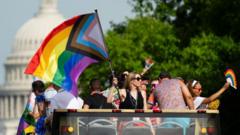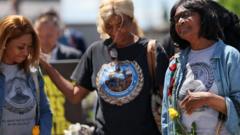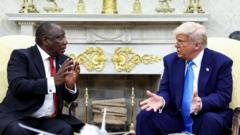In a profound display of unity, thousands of mourners including world leaders gathered in Vatican City to honor Pope Francis during his funeral service at St. Peter's Basilica. The ceremony highlighted his legacy of compassion, humility, and inclusivity amid a time of global conflict.
Mourners Gather in Vatican City for Pope Francis' Funeral

Mourners Gather in Vatican City for Pope Francis' Funeral
A significant farewell as dignitaries and faithful pay respects to the late pontiff, emphasizing his enduring legacy.
Under a clear spring sky, the funeral of Pope Francis attracted red-robed cardinals, world leaders, and countless Roman Catholics, who filled St. Peter's Square to pay their last respects to a pontiff dedicated to fostering a more inclusive church. The morning service commenced with the solemn tones of Gregorian chants and prayers offered in various languages, creating a uniquely reverent atmosphere. Notably, the White House reported that President Trump held a significant meeting with Ukrainian President Volodymyr Zelensky just prior to the ceremony—a backdrop of geopolitical concern existing alongside the religious solemnity.
At the heart of the ceremony, Pope Francis' body lay in a simple wooden coffin, reflecting his wishes for a modest burial befitting his humble approach to the papacy. As dignitaries and pilgrims alike gathered, prayers were led in a procession that conveyed the late Pope's values of compassion and service, underscoring his commitment to marginalized communities and global issues.
Following the funeral Mass, a planned procession would carry the pope's coffin to St. Mary Major, where he will be buried in alignment with his wishes, greeted by those in need— a poignant nod to his life's dedication. While the ceremony embraced simplicity, it also retained elements of grandiosity, with a significant attendance of approximately 250,000 mourners honoring the late pontiff’s memory.
As the funeral concluded, the focus shifted to the College of Cardinals, who will soon convene to deliberate on the election of Pope Francis' successor. This transition signals yet another significant chapter for the Roman Catholic Church, propelled by the legacy of a pope who championed the marginalized and sought to embody the spirit of solidarity and inclusion.
Pope Francis's funeral not only honored a singular life but also called forth reflections on the nature of leadership, community, and humanity at a time when these principles are urgently needed.
In shifting towards a new era, the enduring questions surrounding Francis's legacy and the future direction of the papacy come to the forefront, as observers await the Church’s next steps in navigating the complexities of modern faith and global challenges.
At the heart of the ceremony, Pope Francis' body lay in a simple wooden coffin, reflecting his wishes for a modest burial befitting his humble approach to the papacy. As dignitaries and pilgrims alike gathered, prayers were led in a procession that conveyed the late Pope's values of compassion and service, underscoring his commitment to marginalized communities and global issues.
Following the funeral Mass, a planned procession would carry the pope's coffin to St. Mary Major, where he will be buried in alignment with his wishes, greeted by those in need— a poignant nod to his life's dedication. While the ceremony embraced simplicity, it also retained elements of grandiosity, with a significant attendance of approximately 250,000 mourners honoring the late pontiff’s memory.
As the funeral concluded, the focus shifted to the College of Cardinals, who will soon convene to deliberate on the election of Pope Francis' successor. This transition signals yet another significant chapter for the Roman Catholic Church, propelled by the legacy of a pope who championed the marginalized and sought to embody the spirit of solidarity and inclusion.
Pope Francis's funeral not only honored a singular life but also called forth reflections on the nature of leadership, community, and humanity at a time when these principles are urgently needed.
In shifting towards a new era, the enduring questions surrounding Francis's legacy and the future direction of the papacy come to the forefront, as observers await the Church’s next steps in navigating the complexities of modern faith and global challenges.





















